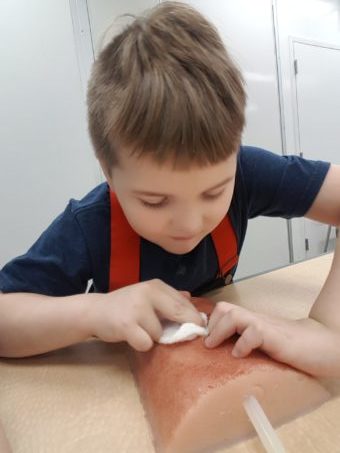
Nathan Concentrating on Packing this Fake Wound
When I originally planned out this curriculum, I was going to continue from the Bone, Muscle, and Skin units into the nervous system, but the opportunity for Nathan to sit-in on a very blood related tourniquet course made me rearrange the plans. Interestingly enough it really does work very well coming after all of the wound care we have been practicing. Not to mention how much this system is really the major factor for hypothermia and heat stroke, which we had also just studied.
It took a little bit of debating and research to come to a decision about whether to call this unit ‘cardiovascular’ or ‘circulatory.’ In the end the title circulatory system includes the cardiovascular system (the heard and artery/vein system) and also the lymphatic system. Although we really aren’t going to go into a lot of detail about the lymphatic system, learning about our blood makes for a very easy segue into learning about it’s response to germs and infection.
Otherwise, the order of these systems doesn’t necessarily matter, especially since they are all tied to one another in one way or another, but whichever one you do first, for instance the circulatory system as written here, will need to include an introduction to the 6 vitals signs. Other than that, when you choose to pull everything together for learning CPR can be at your own personal transgression. Since CPR involves several systems, you can do it with the first one, or wait until you have a better understanding of the Circulatory, Respiratory, and Nervous Systems each.
The basic goals of this unit:
- Learn the parts of the Heart and how it works
- Learn about Arteries and Veins
- Learn about Internal Bleeding and Volume Shock
- Learn how our White Blood Cells respond to Germs and Infection
- Introduce the 6 Vital Signs and their average readings
- Pulse, Respirations, Blood Pressure, Temperature, Skin, and AVPU
- Learn where and how to get Pulse readings
- Learn how and why to check for Distal Perfusion
- Learn to use a Sphygmomanometer for reading blood pressure (Or get an electronic one for ease)
- Learn about AEDs
- Learn what CardioPulmonary Resuscitation is and how to do it. Get CPR certified if age appropriate. (This can also be done after the Respiratory and/or Nervous System Units)
- Learn about hemorrhages, ‘packing’ them, and how and when to use a tourniquet
- Continue practicing blood control protocols for First Responders
- Learn the basic order for an EMT rapid exam
- Learn how to get a full grown unconscious person into the Recovery Position
- Review Acute Stress Reactions
- Continued practice with Triage
- Learn some common Heart, Blood, and Cardiovascular Disorders
- Learn about Hypothermia and Heat Stroke (If you hadn’t done it with the Skin Unit.)
Our Reading Resources for The Heart and Circulatory System:
(Pictures of these books, more details about each, and some helpful links can be found on the Elementary First Responder Home Page.)
- The Cruising the Circulatory System Chapter of “A Trip Through the Body;” pages 18-31
- The Circulatory System Chapter of “The Bones Book;” pages 20-23
- Smithsonian’s “The Heart” by Seymour Simon
- “Body Battles” by Rita Golden Gelman
- The Circulatory, Heart, and Blood sections of Reader Digest’s “How the Body Works;” pages 94-103
- The Exam and Vital Signs sections in the Outward Bound book; pages 16-19
- The General Principles Chapter of the Outward Bound book; pages 2-9
- The Basic Life Support Introduction and BLS Circulatory System sections of the Outward Bound book; pages 26-27, 30-33
- The Circulatory System Chapter in the Outward Bound book; pages 36-44
- The Problems with Body Core Temperature Chapter of the Outward Bound book; pages 138-53 (if you didn’t cover this already with the Skin Unit.)
- The Cardiovascular System chapter of “The Human Body Book” by Parker pages 132-45
- The Lymphatic and Immunity Chapter of “The Human Body Book” by Parker pages 174-87
- NOTE: There is quite a bit of information in this chapter and might be an option for a child who is ready for a more detailed understanding than what “Body Battles” has to offer.
- The Blood Loss and Shock section of of your preferred 1st Aid book. (We have a Boy Scout 1st Aid handbook, a Pediatric First Aid student guide, and the John Hopkins First Aid for Children Fast book)
- The Heart Attack, Cardiac Arrest, and CPR sections of your 1st Aid book, if doing CPR with this Unit.
- SOAP study #1 and #4 in the Wilderness Medicine Workbook
- The Hypothermia and Heat Stroke sections of your 1st Aid book, if you didn’t do this with the Skin Unit.
- SOAP study #25, #26, #27 in the Wilderness Medicine Workbook for Hypothermia and Heat Stroke
- YouTube videos for EMT Rapid Exam and a how to put an unconscious adult into the recovery position
Some Hands-On Activities and Field Trip Ideas
- The Heart activity pages in Scholastic’s “The Body Book”
- The experiments in the Circulation, Heart, and Heartbeat Sections of Reader Digest’s “How the Body Works“
- The experiments in the Body Temperature section of Reader Digest’s “How the Body Works“
- The Heart project in Scholastic’s “Make it Work Body”
- Simple Straw Experiments:
- Blow through a straw and use your finger to block the end. This will create back pressure, like the pressure in blood vessels. You can also get a ‘heart beat’ by tapping your finger on the end while continuing to blow. Punch a small hole in the side and see how the the air ‘hemorrhages’ out.
- Suck water through a straw, then punch a large hole in it to see how a ‘leak’ and blood loss from a hemorrhage can cause issues for this pressure.
- Experiment with different materials to see how each absorbs liquid (or fake blood; recipe in video below). What could be used for an impromptu hemorrhage dressing?
- Dissect/Examine an animal heart
- Use a game heart from a local hunter or a cow heart from the butcher
- Drop the removed heart of a freshly caught fish into a glass of sugar water
- Make a jar of ‘blood’ using vegetable oil for the plasma and polymer clay (fimo) for the red and white blood cells and platelets
- Visit the Blood Bank and/or Donate Blood for your child to watch
- Visit a Dialysis Center (Or save this for the Digestion and Fluid Filtering Unit)
- Practice finding pulse points and taking a pulse (Use a FitBit to Cheat?)
- Practice getting blood pressure readings with a manual or electronic sphygmomanometer.
- OR visit a free screening location at a local pharmacy
- Practice caring for a Hypothermic or Heat Stroke patient
- Practice caring for a patient with shock
- Practice CPR on your own dummy
- OR Visit a CPR training classroom
- AND/OR Get your CPR certification
- Build a Trauma First Aid Kit, including a Tourniquet and Hemostatic Gauze
- Practice using a Tourniquet
- Continue adding to the Personal First Responder Training and Review Book
- A diagram of the Heart, Veins, and Arteries
- A basic diagram of the body’s response to infection and germs
- A print-out of CPR instructions
So how did it go for us?!
So beginning again from my introduction on this page, I had originally planned to have the Circulatory System come after the Nervous and Respiratory Systems and that was the point at which I had planned to really dive into CPR. Well obviously the order got changed for the awesome opportunity we were given to go to a hemorrhage and trauma training class, but on top of that Nathan had already been practicing CPR on his daycare friends, so I figured it was time to really help him understand it’s purpose and how to do it properly. He got a basic introduction when he happened to come along for Andrew and I’s re-cert test for daycare, so I simply read through the sections about it in our First Aid books and made sure he got proper instruction on how to hold his hands with a little more hands-on practice. We’ll continue practicing this skill, and many others, as Cristof randomly gets into incidents and needs Fireman Duley to rescue him.
I was surprised at how quickly we got through all of the reading for this unit. Part of that is due to our using it fill treatment times and since we do those 7 days a week it seems we have been able to move along on the list steadily, but there are SO many projects to choose from that we still spent quite a few more weeks on this unit.
The tourniquet Class was great! Nathan listened SO well through the 2 1/2 hour training, and we each learned a lot of new things. We also got ‘goodies’ and came home with several tourniquets. We kept a SWAT-T and this orange one below out for play, put another SWAT-T in our first aid kit, and put together a very small trauma kit for our truck including and Israeli pressure bandage.
As for getting pulse readings? 6 year old Nathan really was just not able … or less than cooperative about it anyway, so we got him one of those cheap FitBit knock-offs so he can see his pulse easier. It was awesome! He loves to watch his pulse go up and down. He loves to see how many steps he has taken, and it’s novel for him to have a watch. ALSO! You can use your FitBit to find the pulse on anyone. In the case of a real emergency this might be the easiest way anyway!
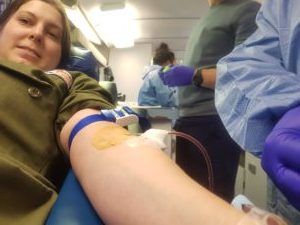
Nathan took a photograph of me donating blood.
Using the electronic sphygmomanometer to get a blood pressure reading was really easy. Understanding exactly what those numbers mean? Not so much again, for the young Mr. Nathan. We just kept it simple and talked about what the numbers should be. He understands that there is pressure in the veins and arteries and that if it’s too high or too low there is a problem. He knows that blood loss will cause low blood pressure. He knows that the blood needs to get to all the parts of the body to keep them alive, and most importantly the brain to keep us alive. How much more do any of the rest of us know about blood pressure anyway?!
I donated blood earlier this year and Nathan got to watch. He also had to get his own blood drawn again at the most recent CF clinic appointment. We’re going to save the Dialysis visit for later. I’ll put it on the Digestion and Fluid Filtering Page.

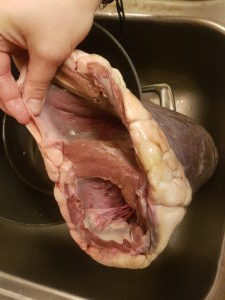
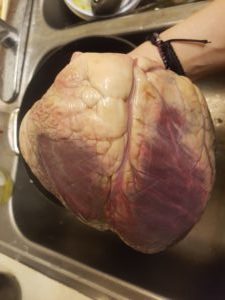
As for the other projects, the balloon circulatory system (above) proved to give us a bit of a hard time. I was going to see about using it for the science fair, but Nathan really doesn’t want to participate so it worked out that we got one half made, he understood what was being represented, and we scrapped struggling to complete it. (It worked fine, we just kept ripping the balloons.) Next we got hands-on with a real moose heart! (also above) And the blood absorption/hemorrhage project went really well. (Short video below)
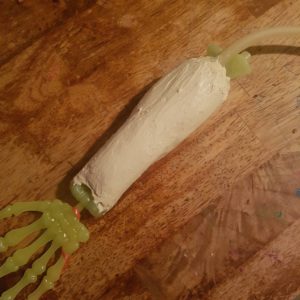 This is what I was able to come up with to replicate the fake wounds we played with at the hemorrhage class. It’s simply Cristof’s plastic skeleton arm and almond colored tub caulking. I added shape to it layer by layer, using a wet paper towel to make it smooth, and then allowed time for each to cure over night. I added more calking to one side or another to get a more realistically shaped forearm. The flexible hose was laid down first and secured around the upper part, leaving the hemorrhaging end open. I made it long enough that it would reach the upper arm when attached and can actually be tourniqueted in the case that we have ‘blood’ pumping through it. When it came time to make the cavity I simply placed really small balloons in the area that I would need to be an open space and siliconed around and over them. After everything had cured and the arm had the desirable shape I cut open the cavity with scissors, and sure enough the end of the hose was without blockage and liquid can easily be sent through. We didn’t use it for the blood experiment above simply because I didn’t want to destroy it with over use. I think I need one of the old hockey style water bottles, with the long hose on top, in order to really pump a decent amount of blood through it. Other than being a little time consuming this was a great project, and full of possibilities for other projects some day.
This is what I was able to come up with to replicate the fake wounds we played with at the hemorrhage class. It’s simply Cristof’s plastic skeleton arm and almond colored tub caulking. I added shape to it layer by layer, using a wet paper towel to make it smooth, and then allowed time for each to cure over night. I added more calking to one side or another to get a more realistically shaped forearm. The flexible hose was laid down first and secured around the upper part, leaving the hemorrhaging end open. I made it long enough that it would reach the upper arm when attached and can actually be tourniqueted in the case that we have ‘blood’ pumping through it. When it came time to make the cavity I simply placed really small balloons in the area that I would need to be an open space and siliconed around and over them. After everything had cured and the arm had the desirable shape I cut open the cavity with scissors, and sure enough the end of the hose was without blockage and liquid can easily be sent through. We didn’t use it for the blood experiment above simply because I didn’t want to destroy it with over use. I think I need one of the old hockey style water bottles, with the long hose on top, in order to really pump a decent amount of blood through it. Other than being a little time consuming this was a great project, and full of possibilities for other projects some day.
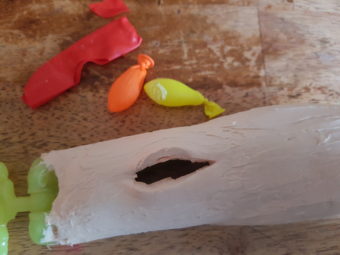
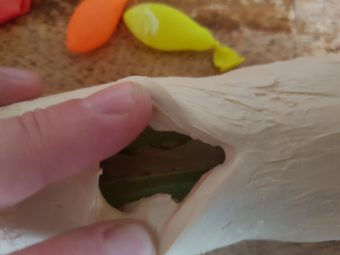

Post a comment